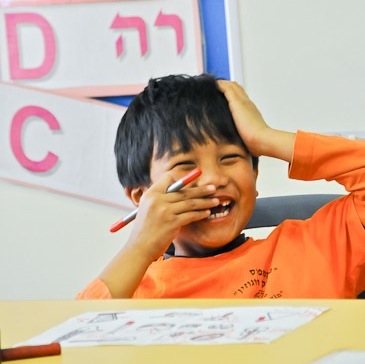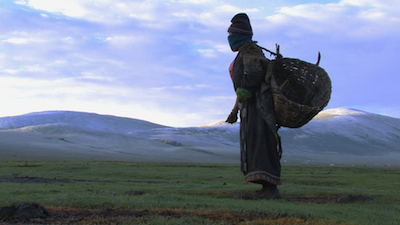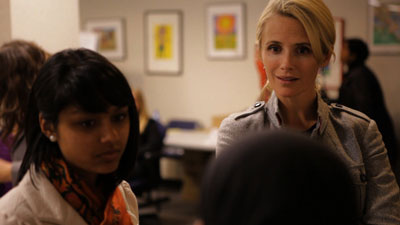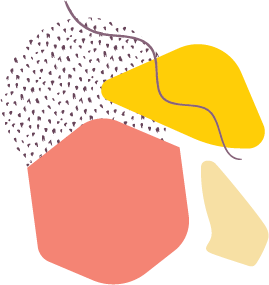“We Still Live Here – Âs Nutayuneân” tells the amazing story of the return of the Wampanoag language, a Native American language silenced for more than a century. The Wampanoag Indians’ forebears ensured the survival of the first English settlers in New England – the ‘Pilgrims,’ and lived to regret it. A century ago, after nearly 300 years of contact, their language virtually disappeared. Now, spurred on by an indomitable Wampanoag woman named Jessie Little Doe Baird, recent winner of a MacArthur genius award for her unprecedented linguistic work, the Wampanoag are bringing their language and their culture back to life.Like many Native American stories, this one begins with a vision. Years ago, Jessie Little Doe, a young Wampanoag social worker, began having recurring dreams: familiar-looking people from another time addressing her in an incomprehensible language. Jessie was perplexed and a little annoyed– why couldn’t they speak English? Later, she came to believe that they were speaking Wampanoag, a language no one had used for more than a century. These events sent her on an odyssey that would uncover hundreds old documents written in Wampanoag, lead her to a Masters in Linguistics at MIT with renowned linguists Ken Hale and Noam Chomsky, and result in her accomplishing something that had never been done before – bringing a language with no speakers for many generations alive again in a Native American community. Her six-year-old daughter, Mae Alice, is the first Native speaker in a century.The film interweaves the present day story of Jessie and other Wampanoags working to reclaim their language, with commentary and expressionistic animation that reveal dark moments in New England history– epidemics, missionary pressures, land loss, the enslavement of families and the indenture of Native children – that silenced the language and nearly obliterated Wampanoag culture. Ruth Lingford’s devastatingly poignant animation provides powerful visuals as Wampanoags recount these horrific events.
Summary info for schedule – will be hidden on film page

We Still Live Here
60-minutes
Screening day / time
We Still Live Here
Filmmaker(s)
Running Time
We Still Live Here
Filmmaker Notes:
I met Jessie Little Doe Baird and other members of the Wampanoag nation early in 2006 while working on a documentary about their history. I was utterly amazed by the astonishing work Jessie and others were doing to bring back their long forgotten language. A year later, I realized that the film I really wanted to make was was the story of the unprecedented resurrection of a language and a culture. At the same time, I hoped to reveal the dark history that had forced the language underground, and to tell this story as much as possible through Wampanoag voices.When I first got the idea, I met with Jessie Little Doe Baird and Linda Coombs to talk to them about the project to see whether they would support the idea. I had some confessions to make first. I told them that I was deeply and passionately drawn to their story, that I couldn’t really explain why but that it could have to do with the fact that my ancestors were on the wrong side of this history. Makepeace is an old Puritan name; my ancestors were involved with violent massacres of Wampanoags in the 17th Century during King Philip’s War, and distant Makepeace relatives now own hundreds of acres of Wampanoag land. I told them that my connection to their story didn’t feel like ‘white guilt,’ but something stronger and more compelling, more like falling in love, which in fact is what has to happen in order to make it possible to make a film. They listened intently, and then one of them simply said, “You’re closing the circle.”Early in the fall of 2007, I met with members of the Wampanoag Language Reclamation Program (WLRP) to ask their permission to make a film about their story. Jessie’s and Linda’s support opened the door to this meeting, but the final decision would be made by consensus of the whole group. This was a huge decision and a very dramatic moment. Up until that time, WLRP had not allowed their language to be used in anything that could be sold, including books, films, curricula etc. The language is sacred, and the Wampanoag feel that it is very important that they learn it before others do. Entrusting an outsider with this story was going to be a big leap. But I had worked with them on the other project for a year, developing relationships and trust, and after a many eloquent speeches for and against, they voted unanimously to support and participate in the documentary.I began filming at the Aquinnah Pow Wow on Martha’s Vineyard in September 2007, before I had raised any funds for the production. Fortunately the Sundance Documentary Fund awarded the project a development grant in November of that year, and six months later, the Massachusetts Foundation for the Humanities gave the project further development funds.Over the next three years, I filmed with Jessie Little Doe Baird, Linda Coombs, Tobias Vanderhoop, Hartman Deetz, Earl Mills Sr. and Jr., Chief Vernon Lopez, and many other Wampanoags, in their homes and their language classes, their Total Immersion language camp, and in many other situations. I also met with Noam Chomsky and with Norvin Richards, an MIT linguist who continues to work with Jessie to create teaching tools and the Wampanoag dictionary. I also filmed 17th and 18th century Wampanoag documents, including the Wampanoag Bible published at Harvard in 1662, the first Bible published in the Western Hemisphere. Unbeknownst to the missionary who created this Bible for the purpose of converting the Wampanoag to Christianity, his work would become the Rosetta Stone for bringing the Wampanoag language and culture back home.In the fall of 2008, I was very fortunate to receive fellowships from both the Guggenheim Foundation and the Radcliffe Institute for Advanced Study in support of the film. These fellowships and a production grant from the Sundance Documentary Fund enabled me to complete 90% of production by the end of 2009. Funding from the National Science Foundation and from ITVS, the independent arm of the Corporation for Public Broadcasting, released postproduction funds in July 2010, enabling me to hire an editor and finish the film just before Thanksgiving 2010.Since January 2011, We Still Live Here has been having terrific exposure, with screenings in academic institutions, at film festivals across the country, and in both Native and non-Native communities. A few of the screenings to date are: at the Carnegie Institution for Science in Washington DC as part of the Environmental Film Festival; in the prestigious Stranger than Fiction Series at the IFC Center in New York City; at the Endangered Language Archive festival at the University of London, at the Stabilizing Indigenous Languages Symposium in Albuquerque, at the Beeld voor Beeld anthropological film festival in Amsterdam, and at the Library of Congress, during the National Native Language Revitalization Summit. To date We Still Live Here – Âs Nutayuneân has won two important and prestigious awards: the Inspiration Award at the Full Frame Documentary Film Festival, a $5000 prize; and the Moving Mountains Award at Telluride MountainFilm. The Moving Mountains award is given to the NGO portrayed in a film that has the most important social impact. And the $3000 prize that went directly to the Wampanoag Language Reclamation Program. WLRP is using the prize money for their first ever language immersion camp for children, to be held this month (August 2011).The film will reach its largest audience on November 17th, 2011 when it airs nationally on PBS’s Independent Lens series. The PBS News Hour will devote a segment, with clips and interview material, to promote the film during the week before the broadcast. Independent Lens has also chosen to feature the film in its Community Cinema program, for which they will organize screenings with expert panel discussions in 100 cities across America. Other upcoming events include screenings of the film at the New Bedford Whaling Museum and at Plimoth Plantation in September; at the National Indian Education Association conference in October; and at the Society for Visual Anthropology Film Festival in Quebec and the Margaret Mead Film Festival at the New York Museum of Natural History in November, and at the Linguistic Society of America’s conference in Portland in January. Please see http://www.makepeaceproductions.com/Press-WeStillLiveHere/index.html for a full list of past and planned screenings and events.Many more convenings around Native language revitalization are slated for the year ahead. Some of these venues include: the Conference on Endangered Languages and Cultures of Native America (Utah), the National Congress of American Indians in October (Oregon) and the Native American and Indigenous Studies Association June 2012 Conference on the Pequot Reservation (Connecticut). We are also in preliminary conversations with the American Indian Higher Education Consortium to arrange screenings at up to 30 tribal colleges across the United States.In addition to these larger presentations at schools and conferences, a central component of the campaign will be to heighten Native Language Awareness among people within their own communities by holding a series of smaller, grassroots events on reservations and other Native enclaves. These will be intergenerational and inspirational gatherings that bring together youth with questions to ask and elders with stories and knowledge to share. Our coProducer Jennifer Weston’s strong relationships, through Cultural Survival (culturalsurvival.org) with over 300 Native communities will enable us to quickly make contacts, gain trust, and organize these gatherings effectively.We have also received a grant from the Independent Television Service to produce a wide-ranging interactive website, tentatively called Native Tongues, about the issue of endangered languages, featuring eleven language programs from Alaska to Oklahoma. The website will launch in conjunction with the PBS broadcast in November.




